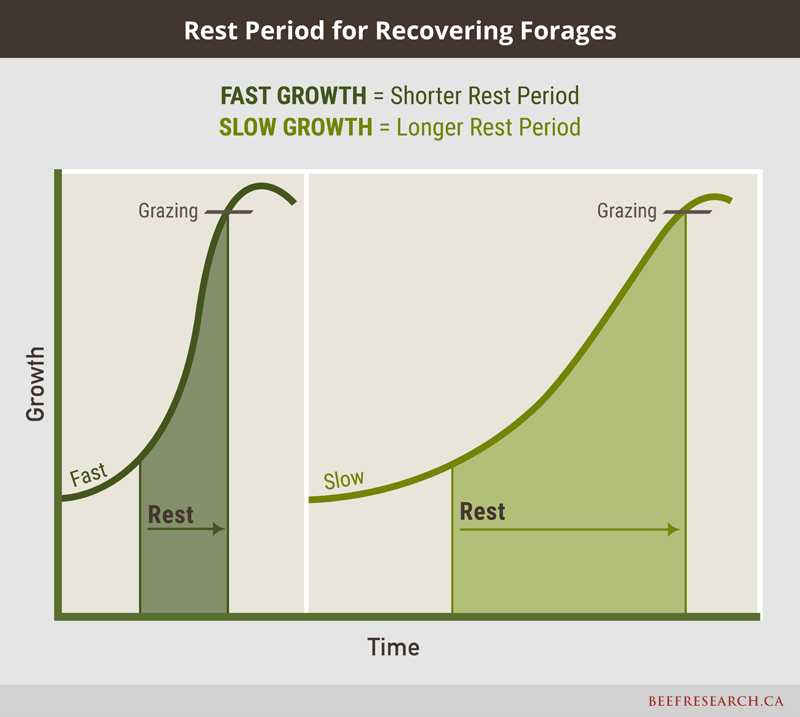Optimisation de la santé des pâturages : Un guide pratique pour la mise en œuvre du pâturage de style « prendre la moitié, laisser la moitié ». ▶️🎙️
CLIQUEZ SUR LE BOUTON « PLAY » POUR ÉCOUTER CET ÉPISODE (article offert en anglais seulement):
Écoutez d’autres épisodes sur BeefResearch.ca, Spotify, Apple Podcasts, Amazon Music ou Podbean.

Lorsque vous apportez des changements à votre exploitation de bovins de boucherie, commencer par des étapes simples et gérables est la clé pour obtenir des améliorations durables. C’est le cas avec le concept « prendre la moitié, laisser la moitié », qui est une règle de base pour la gestion des pâturages qui peut être mise en œuvre efficacement dans n’importe quelle région, les années de beau temps comme de mauvais temps.
Dans une vidéo récente du BCRC, Breeanna Kelln, professeure adjointe à l’Université de la Saskatchewan et agricultrice/ productrice vache-veau au nord de Regina, a présenté deux méthodes pour déterminer le fourrage disponible et pour estimer quand 50 % du fourrage a été utilisé. Dre Kelln explique : « Il est important de laisser un peu de matière verte pour que la plante puisse encore faire de la photosynthèse et absorber de l’énergie dans ses racines afin que le pâturage puisse persister et passer l’hiver. »
Prendre la moitié, laisser la moitié – Méthode 1
La méthode 1 utilise la hauteur comme stratégie rapide et facile pour estimer le volume de fourrage disponible pour paître. Il suffit de mesurer la hauteur du fourrage souhaité à environ 20 endroits différents, de noter la hauteur moyenne et de retirer les bovins de ce peuplement une fois que la hauteur moyenne est réduite de moitié.
Prendre la moitié, laisser la moitié – Méthode 2
La méthode 2 utilise le poids, ce qui demande plus de travail mais permet de déterminer avec plus de précision le moment où 50 % du matériel végétal est utilisé. Il s’agit de couper quelques échantillons de fourrage dans le pâturage, aussi près du sol que possible, de lier le bas avec un élastique, puis de trouver le point médian en faisant reposer l’échantillon sur votre doigt jusqu’à ce que le fourrage soit droit et régulier. Enfin, coupez le matériel végétal au sommet, ce qui permet d’obtenir une représentation visuelle de ce à quoi ressembleront les plantes en croissance une fois que 50 % du matériel végétal, en fonction du poids, aura été utilisé.
L’une ou l’autre méthode est un moyen efficace de commencer à reconnaître ce avec quoi vous commencez et ce à quoi ressemble réellement l’utilisation de 50 %.
Principales considérations
- Ne regardez et ne mesurez que les principaux fourrages nutritifs du peuplement du pâturage. N’incluez pas les mauvaises herbes ou le matériel végétal indésirables ou antinutritionnels.
- Prenez les mesures avant de laisser les boivins aller dans le champ, idéalement tout de suite avant de l’introduire dans le nouveau secteur.
- Plus vous faites paître votre bétail, plus le pâturage a besoin de temps pour se reposer.
- Connaître les espèces végétales de votre pâturage peut faciliter le pâturage de manière stratégique tout au long de la saison.
Lorsque vous prenez ces mesures avant le pâturage, assurez-vous de n’inclure que la partie du pâturage qui sera consommée par les bovins. Par exemple, si votre pâturage est composé à moitié de mauvaises herbes et à moitié de fourrage, le fait de faire paître le fourrage jusqu’au sol alors que les mauvaises herbes restent intactes n’est pas conforme au principe « prendre la moitié, laisser la moitié ». Dans ce cas, vous ne tiendriez compte que de la partie fourragère du pâturage, qui représente 50 % de la masse végétale, ce qui signifie que 25 % de la masse végétale totale du champ seront utilisés pour appliquer efficacement le principe « prendre la moitié, laisser la moitié ».
Bien que le principe « prendre la moitié, laisser la moitié » puisse servir de guide, « la quantité que vous faites paître est vraiment déterminée par la durée pendant laquelle vous êtes en mesure de laisser la plante se reposer », explique Dre Kelln. Elle ajoute qu’il peut être correct de faire pâturer 60, 70 ou 80 % des parties épigées, à condition que le pâturage ait le temps de repousser. « Plus on enlève de matière, plus le pâturage a besoin de temps pour se reposer. »
La professeure de l’Université de la Saskatchewan définit le surpâturage comme une fonction du temps et le fait de ne pas laisser aux pâturages le temps nécessaire pour récupérer afin d’être à nouveau pâturés ou de survivre à l’hiver. « Si nous enlevons trop du dessus des plantes et que nous ne leur laissons pas le temps de se reposer pendant qu’elles sont en pleine croissance, nous risquons de voir ces plantes dépérir et des espèces indésirables s’introduire dans le pâturage, ainsi qu’une baisse de la productivité. »
Le fait de ne pas accorder un repos suffisant peut également entraîner des conséquences sur la santé des animaux, comme une augmentation de la charge parasitaire et des comportements de sélection non idéaux, ce qui a un impact sur la santé et la longévité de votre pâturage à long terme.
Dre Kelln ajoute que si les producteurs souhaitent mettre en œuvre un régime de pacage plus lourd et plus intensif et qu’ils ont prévu de le faire, cela peut s’avérer très fructueux. Mais elle insiste sur le fait qu’il est important de « connaître les plantes qui s’y trouvent, de les cibler au bon moment et de leur permettre de se reposer au bon moment. » Faire paître un peuplement plus que prévu dans un moment difficile, en période de sécheresse ou lorsque le fourrage est peu abondant est le genre de chose qui peut mener à des complications.
En ce qui concerne la gestion du pâturage, sachez ce que vous avez, ayez un plan, exécutez ce plan au mieux de vos capacités et ayez toujours un plan B… peut-être même un plan C.
Le partage ou la réimpression des publications du BCRC sont les bienvenus et sont encouragés. Veuillez mentionner le Beef Cattle Research Council, fournir l’adresse du site Web, www.BeefResearch.ca, et nous faire savoir que vous avez choisi de partager l’article en nous envoyant un courriel à info@beefresearch.ca.
Vos questions, commentaires et suggestions sont les bienvenus. Contactez-nous directement ou lancez une discussion publique en publiant vos idées ci-dessous.
